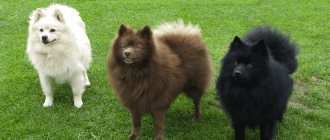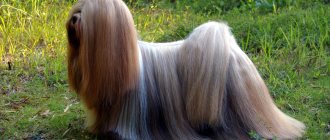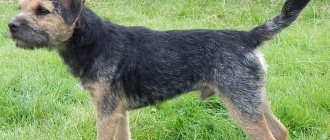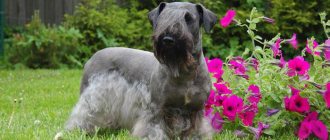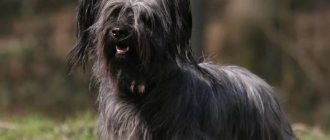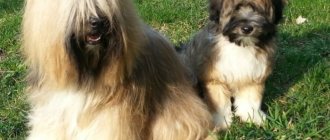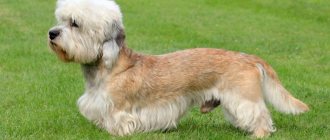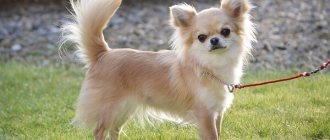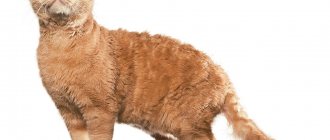Breed characteristics
| Short description | |
| Origin: | Germany |
| Conditions of detention: | Country house with a large plot, apartment |
| Purpose: | Hunter |
| Color: | Black or brown and tan |
| Wool length: | 2 – 4 cm |
| Adult dog size: | Height 34 – 39 cm, weight 8 – 10 kg |
| Average life expectancy: | 13 – 15 years |
| Walk: | Mandatory, daily |
| Physical activity needs: | High, from 3 hours a day |
| Fédération Cynologique Internationale (FIC) classification: | Group 3, section 1 |
| Puppy price: | From 5,000 to 35,000 rubles |
Breed card
- Known breed names: Jagdterrier, German Hunting Terrier, Jagdterrier, Deutscher Jagdterrier, German Hunting Terrier
- FCI breed number: 103
- Standard on the FCI website (English): link
- Height at withers: from 33 to 40 cm
- Weight of an adult dog: working males 9-10 kg, females 7.5-8.5 kg
- Color options: black, black-gray and brown, preferably dark tones
- Life expectancy: up to 12-15 years
- Puppy cost: from 8,000 rubles to 20,000 rubles
- Size: 4 out of 5
- Shedding intensity: 2 out of 5
- Protective and guard qualities: 3 out of 5
- Physical Activity Need: 5 out of 5
- Accommodation with other animals: 1 out of 5
- Aviary maintenance: 4 out of 5
- Learning ability: 4 out of 5
- Attitude towards children: 3 out of 5
History of the origin of the species
The history of the breed is not shrouded in myths and legends, due to the relative youth of the species - Jagdterriers trace their gene pool from fox terriers rejected for color. In the 20s of the 20th century, exhibitions became fashionable, and the selection of fox terriers was aimed at the exterior, which significantly reduced the working qualities of the dogs. Walter Zangenberg, a hunter and owner of fox terriers, was disappointed with the new characteristics of the breed, and was inspired by the idea of breeding a new species - ideal for hunting.
To the defective fox terriers, Walter mixed the genetic codes of English wire-haired terriers, Welsh terriers and other dogs with first-class working qualities, relegating appearance to the background. In just 10 years, Zangenberg managed to get two hundred black and tan dogs of the same type, which he named German Jagdterrier . But the International Canine Federation accepted the breed only in 1954.
Description of the Jagdterrier breed
The Jagdterrier is a relatively young breed, about 60 years old. Currently, there are two varieties - the long-haired, which has elongated hair on the body and face, and the smooth-haired Jagdterrier .
Representatives of the breed have extremely hardy health. This is due to both physical strength endurance and resistance to various diseases. These physical qualities make the strong Jagdterrier an excellent hunter. Despite the fact that in the photo Jagdterriers seem to be small and cute dogs, this opinion is wrong.
Distinctive features
Description of the German Jagdterrier breed:
- General form. A strong, compact dog with a slightly stretched format.
- Height. At the withers, males have 34–40 cm, females 33–39 cm, weight 8–10 kg and 7–9 kg, respectively.
- Head. Small, wedge-shaped, tapering towards the nose. The occipital protuberance and the transition from the forehead to the muzzle are poorly defined. The eyes are symmetrically located, the shape is close to almond-shaped, brown or dark brown in color. The ears are small, triangular with a crease in the cartilage, set high and close to each other.
- Muzzle. Narrow, nose black or brown, lips tightly fitting. Scissor bite, jaws strong, teeth tightly clenched.
- Neck. Dry, without dewlap, with pronounced muscles.
- Frame. Compact but muscular, lacking dampness. The stomach is tucked in, the back is straight and strong. The ribs protrude slightly, the chest is moderately wide, descending to the level of the elbows.
- Limbs. Straight, parallel, fingers closed. The thighs are strong, muscular, the hock joints are well defined.
- Tail. It is docked and 2/3 is left. Set on moderately, in an excited state the dog holds it above the level of the back.
- Coat and color. The coat is thick and dense, in two variations - wire-haired and smooth-haired. There is very little undercoat. Colors are black or brown and tan.
Sexual dimorphism is moderately expressed and is welcomed in exterior assessment.
History of the breed
The German Jagd Terrier was bred in Germany recently, at the beginning of the 20th century. The goal was to create a hunting dog that was easy to care for and capable of working in burrows, on water and in the field. The hunters needed an assistant, vicious towards the beast, non-marking color, small in size (for working in the hole). In addition, they were sure that in the field the white color of the dog would scare away game.
Fox Terrier puppies that were rejected for their black and tan color were selected. To obtain the necessary working qualities, they were crossed with fox terriers (of as dark a color as possible); the priority was precisely hunting and working qualities.
German hunter
To reduce the negative consequences of inbreeding (inbreeding), blood from Welsh Terriers and Old English Terriers was added.
Already in the 40s of the past, a breed of German hunting terrier was practically created, which had:
- good instinct;
- lack of fear of water;
- exceptional malice towards the beast;
- confident normal work;
- the ability to conduct an uncompromising fight with game;
- rather unpresentable appearance. Description and breed standard
According to the FCI standard, Jagd Terrier dogs must have the following properties and characteristics:
- The chest circumference should be 10-12 cm greater than the height at the withers (a chest that is too wide will interfere with work in the hole).
- The length of the body is slightly greater than the height at the withers.
- Full, scissor bite; full dental formula (42 teeth).
- The nose is black in black and tan, and brown in dark brown.
- The ears are triangular, set high, slightly adjacent to the cheekbones.
- The eyes are small, dark, the eyelids are tight-fitting, dark.
- The tail is set high, horizontal in relation to the body; docking in countries where it is allowed is allowed by half or even 1/3.
- Light and dark masks are allowed.
- Small white markings on the chest and toes are acceptable.
FCI Standard
The standard has two varieties:
- smooth-haired Jagdterrier;
- Wire-haired Jagdterrier.
Wire-haired individuals have a well-defined beard; The hair on the paws and body is longer than that of their short-haired counterparts. The dog's coat is thick and dense, with a good, dense undercoat. The belly is not “naked”, but is covered with rather thick hair.
The color of both varieties is black, dark brown with tan. The color of the tan marks can be red, yellowish, or brown. Markings are located on the muzzle, above the eyes, on the paws, and around the anus.
| Height (height at withers) | Weight | |
| Males | 33-40 cm | 9-10 |
| Bitches | 33-40 cm | 7.5-8.5 kg |
Photo of an adult dog
Photos of puppies
Smooth-haired Jagdterrier photo
Features of behavior
As befits a real hunter, the Jagdterrier is distinguished by exceptional energy. This is a dog who never sits still. And if the energy is not directed in a peaceful direction, the child begins to look for things to do on his own - chewing furniture, digging holes, chasing cats. It is absolutely not suitable for lazy and melancholy people, but in hunting or sports the breed has no equal.
To this day, the Jagdterrier has retained amazing working qualities. This dog has an excellent sense of smell, endurance and a desire to work, thanks to which the breed is gradually moving from a burrow hunter into the category of universal hunters. Yagi are capable of hunting small burrow predators, swamp and steppe game, and ungulates with equal success.
The German Hunting Terrier cannot be called a dog with high communication skills. The breed does not get along well with other animals (especially rodents or birds); due to its innate leadership qualities, the dog can start fights on the street with other dogs. Treats strangers with caution, but without excessive aggression. Although with a good level of early socialization this deficiency can be reduced, it cannot be completely eradicated.
Another feature of the breed is courage, absolute and sometimes reckless. When going out to fight a predator, or defending a dog’s owner, the instinct of self-preservation is completely turned off. Which is fraught with injury, since the Jagdterrier’s opponent’s size never stops him; he is ready to fight to the death with anyone.
The breed is not suitable for novice dog breeders; it has a complex character. During educational processes, a poorly motivated child often displays remarkable stubbornness and self-will. And with harsh correction methods, he may snap back. Hunting breeds that do not know how to show independence in real hunting conditions are doomed to death; in Jagdterriers it is this trait that complicates the educational process.
Advantages
The German Hunting Terrier has a lot of advantages:
- Intelligence and quick reaction;
- Irrepressible energy;
- Strength and endurance;
- Good hunting instinct;
- Excellent hearing and sense of smell;
- Courage;
- Ability to make independent decisions;
- Compact dimensions;
- Easy to care for;
- Good health;
- Good security qualities;
- Unpretentiousness in content.
All the advantages of this little dog cannot be included in one list.
Flaws
Of course, despite all the advantages of the breed, there are also disadvantages:
- Poor level of communication;
- Hyperactivity;
- Lack of self-preservation instinct;
- Difficulty in training;
- Stubbornness;
- Frequent injuries.
Unbridled energy, splashing from a small body, from an advantage, easily turns into a disadvantage, if the content is inappropriate for this breed.
Hunting with a Jagdterrier
The breed was bred for the purpose of hunting foxes and badgers in holes, but these fearless and strong dogs are also used in other types of hunting.
On the boar
Most hunting breeds work against boar from a distance. They do not engage in battle, but only stop and surround the animal and signal its location with a ringing bark. But the fearless Jagdterrier, which has a special fighting character, often enters into an unequal battle with a wild boar, which is why there are frequent cases of pet deaths.
Hunting a wild boar with a Jagdterrier begins with searching for the animal and its habitat. Only then can the Jagdterriers be used. Baiting of wild boars begins when they reach two years of age. The preferred method of hunting is round-up.
For the hare
Hare hunting with a Jagdterrier differs from hunting with hounds and has its own characteristics. Jagdterriers work in a small circle and, having completed it, stop the pursuit. In turn, the hare, feeling that there is no pursuit of him, calms down and slows down, which gives the hunter an excellent chance to take him. An important feature in hare hunting is to take the correct position to make a good shot.
On the badger and the fox
Burrow hunting is carried out in a discovered inhabited hole. They can usually be found on slopes. Jagdterriers move well in narrow badger holes due to their squat structure. Bites from animals, badgers or foxes, are not dangerous for this breed. Their hard, thick fur protects them from bites. When an animal is found in a hole, the Jagdterrier pulls it out, and this is where its work ends. When hunting, be sure to remove the collar from your dog.
For waterfowl
Dogs of this breed are excellent swimmers and can withstand low temperatures. Jagdterriers easily rush into cold water to get a killed duck, and serve it to the owner in a boat or on the shore. Dogs can also participate in hunting other birds, easily finding game. After the shot, the dog finds and delivers the killed bird or wounded animal. The stance of a pointer is not typical for the Jagdterrier. Dogs of this breed can find small game that has taken a fancy to agricultural fields, and also find birds in corn.
Care and maintenance
The ideal housing option for a German Hunting Terrier is a country house with a large and securely fenced area. But a spacious area for a splash of energy does not mean that you don’t have to exercise your dog; out of boredom, the dog will dig holes and gnaw trees and bushes on the site. Having your own reservation does not eliminate the need to walk and socialize the yagda.
The compact dimensions of the breed allow you to keep the yagda in an apartment, but subject to daily active walking for at least 3 hours a day.
Otherwise, caring for a Jagdterrier is not a hassle:
- Clean your ears from dirt once every two weeks;
- Brush your teeth once a month;
- Carry out a preventive dental examination at the veterinarian twice a year;
- Once a week, wipe your eyes with a special lotion;
- Carry out preventive deworming once a trimester;
- Vaccinate against infectious diseases once a year;
- As necessary, carry out ectoparasite prevention.
In fact, this is a minimum set of procedures for caring for a dog.
Nutrition
The recommended feeding regimen for dogs is presented in the table:
| Age | Mode |
| 1 – 3 months | Fractional feeding in small portions every 3 hours 6 – 7 times a day |
| 3-5 months | 5 times a day |
| 5 – 7 months | 4 times a day |
| 7 – 11 months | 3 times per day |
| 11 or more months | It is acceptable to switch to the adult dog’s regimen – 2 feedings per day |
As for the diet, the choice is up to the owner - Jagdterriers are healthy dogs, the owner’s task is only to maintain the animal’s condition with decent nutrition.
Dry food of good quality costs a lot of money, but decent feeding with natural products takes a lot of time, and financially it doesn’t work out much cheaper.
Authorized products:
- Meat (any except fatty variations - lamb and pork) and offal (any except kidneys and liver). Should form the basis of the diet. A carnivore does not need to cook meat.
- Fish. Any varieties of white sea fish without bones, it is enough to give once a week.
- Fermented milk. With fat content no higher than 5%.
- Eggs. Only the white is better; boiled yolks have a lot of sugar.
- Cereals. The source of complex carbohydrates is oatmeal and rice, but no more than 10% of the total diet; the dog will not receive anything useful except excess weight if there is an excess of cereals.
- Cartilage and tendons. Also in raw form, very rich in protein.
- Vegetables and unsweetened fruits. Only in fresh form, otherwise they have no vitamin value.
Prohibited Products:
- Sweets, including sweet fruits (such as grapes)
- Flour products. With the exception of dried rye bread.
- Sausages and smoked meats.
- Salt and spices are also not needed by the predator.
- Marinades.
- Sharp or tubular bones.
All these products can cause acute and chronic diseases of the stomach, pancreas or injure the esophagus. And cereals such as millet, semolina, and pearl barley are not digestible in the dog’s body.
We recommend that you read a detailed article on the topic: “How and what to feed a dog: types and characteristics of nutrition.”
Health
Breeders, when breeding the breed, tried to avoid common genetic diseases - successfully . Today, breeders actively continue to work to maintain the state of the gene pool in the same form. Sick individuals (both physically and mentally) are completely excluded from breeding. Thanks to this, with proper care, Jagdterriers can easily live up to 14 - 15 years , without age-related or breed-related ailments.
The only problem that the owner of a jagda may encounter is injuries received in fights with wild or other domestic animals.
Vaccinations
- The first veterinary procedures must be carried out by the breeder - at about 6 weeks, prevent helminths for the entire litter, and after 2 weeks, double deworming.
- By the 10th week of life (no later), the owner must provide a vaccine against a minimum set of viral infections - enteritis, Carré's disease and viral hepatitis.
- Additionally, your veterinarian may prescribe another vaccine against a disease found in a particular region.
- After 28–30 days , a double vaccination is given to strengthen immunity. If the puppy is healthy and active, they immediately give an injection for rabies. If the dog lives in “greenhouse” conditions, the doctor may postpone the rabies vaccination until the teeth are completely replaced.
- After revaccination, it is recommended to observe another 2 weeks of quarantine.
- The last puppy vaccination is given at the age of 12 months . Then, every year, immunization against rabies and viral infections is carried out (with one or two sera).
Preventive deworming is carried out before each vaccine.
On the days of veterinary procedures, the pet may experience lethargy, drowsiness, lack of interest in active games, one-time refusal to feed, and even one-time vomiting. Allergic reactions to modern medications practically do not happen.
Important article on the topic: “Everything you need to know about dog vaccinations.”
Diseases
There is no visible tendency towards genetic diseases. Completely healthy breed.
Walk
Regardless of living conditions (house, enclosure, apartment), the Jagd Terrier requires a mandatory daily walk - at least 3 hours a day. At the same time, the pet needs not only to run, but also to receive mental exercise. Without a proper outburst of activity, the dog is inclined to exhibit destructive behavior.
Even working dogs that go fishing during the season are recommended to simultaneously engage in obedience walks or canine sports. The breed is perfect for canicross, frisbee dog, agility, and bikejoring.
Grooming
To care for the coat of a Jagdterrier, no special skills or equipment are required - it is enough to comb out dead hairs with a slicker brush or furminator once a week, during the period of seasonal molting - every other day.
Bathing procedures are also not required too often, especially if the dog lives in an enclosure. Berries need to be washed no more than 3-4 times a year, but for dogs kept in enclosures, one wash per year is enough.
Maintenance, care and nutrition
The size of the animal allows it to be kept both in an apartment and in a country house. The second option is preferable. Unchaining a dog on a site is possible if the area is surrounded by a solid fence with a deep foundation. Otherwise, the terrier can easily escape by digging.
The dog needs a spacious enclosure. He needs to constantly splash out his energy. However, it is impossible to get by with aviary maintenance alone. Training, active games and training are carried out in open areas. Walking terriers is mandatory even when living in a country house.
Keeping a Jagd Terrier dog in an apartment means taking into account all the nuances of the pet’s behavior and needs.
- Mandatory walk 2 times a day. One walk is at least 1-2 hours.
- Each walk is active: running, outdoor games. Mandatory training.
- Off-leash is prohibited within the city. The Terrier has a tendency to throw itself in front of cars.
- The owner is required to be attentive while walking. The terrier constantly hunts various living creatures (cats, dogs, birds). He can easily snag a defenseless kitten or get into a fight with a street dog.
- It is forbidden to feed your pet before a walk.
- It is better to train an animal in specially designated areas.
- Keep an eye on your pet when the door to the apartment is open. Terriers are prone to running away.
- Frequent damage to property in cases where the dog is left at home for a long time.
- Providing your dog with plenty of his own toys.
The terrier is unpretentious in grooming. The dog's coat is water-repellent. They should be bathed as needed. If the wool is very dirty, then when washing you need to use mild types of shampoos; they do not wash away the protective fats.
Shedding in terriers is discreet and passes quickly. But they should be brushed about once a week with a special brush. The process replaces the cleaning and washing procedure. Trimming is performed to remove dead and old hairs. Its frequency is about 3 times a year.
The terrier's eyes should be regularly wiped with chamomile infusion using cotton pads. Ears should be checked for wax, removing as necessary. The pet's mouth and teeth can be cleaned using special sticks or brushes. Nails should be trimmed as they grow. In winter, this procedure is performed more often.
The terrier's diet can consist of prepared or natural products. Dry feeding should only include high quality foods. Food of the premium and super-premium categories allows you to provide the Jagd Terrier with the necessary vitamins.
A dog's daily natural diet should consist of:
- beef broth;
- poultry or beef by-products;
- fermented milk products;
- cereals, except semolina;
- vegetables
It is forbidden to feed the Jagdterrier sweet, salty, fatty, fried or smoked food, as well as add spices to food.
The daily intake of dry food is from 150 to 200 grams. If the Jagdterrier is on natural food, then he needs to be given from 240 to 320 grams of food per 24 hours. With the second feeding option, you should give the terrier additional vitamins. To do this, you need to contact a veterinarian who will prescribe the necessary medications.
Pregnant females should be fed 3 times a day. For the first 2.5 months of life, the pet should eat frequently: about 5 times a day. Up to 4 months, the baby eats 4 times a day. Afterwards he must be switched to three meals a day.
When the puppy reaches eight months of age, he is transferred to two meals a day.
For the first 2 months of life, the puppy must be fed according to the following regimen:
- breakfast: milk with yogurt;
- three hours later: cereal soaked overnight in meat broth or milk;
- lunch: raw meat scalded with boiling water and boiled vegetables;
- afternoon snack: cottage cheese or porridge;
- dinner: raw meat scalded with boiling water.
- About 2 times a week you need to give the puppy a yolk and add garlic to the broth.
Features of feeding berries up to 4 months include:
- dairy products - in the morning;
- vegetables for lunch;
- For the remaining two feedings, distribute meat and fish products;
- Gradual increase in portions.
Up to 8 months, food distribution occurs as follows:
- morning: dairy products;
- day: boiled vegetables;
- evening: meat with additives.
During this period it is also necessary to increase portions.
Next, you need to divide your food intake into two times. You should give your Jagdterrier dairy products and vegetables for breakfast, and meat and supplements for dinner. Such nutrition will promote the absorption of nutrients in the terrier’s body throughout the entire period of growing up.
Frequent “reinforcement” will help the puppy not to lose dexterity and attentiveness during training and training. The pet will be constantly energetic and cheerful, which contributes to better absorption of information. Therefore, it is important to follow the animal’s diet.
Mating
According to the regulations on breeding work published on the website of the Russian Cynological Federation, completely healthy individuals who have reached the age of 18 months are allowed to breed . In females, this is usually the third estrus.
A prerequisite for mating is to meet a male on the territory; females often behave aggressively on their reservation.
Mating is prescribed on days 9–14 of estrus ; depending on the characteristics of the body, ovulation does not occur on a specific day. To obtain reliable information about readiness for mating, it is recommended to take a special ovulation test (the male is ready for mating all year round). Before mating, both individuals need to be treated against parasites and vaccinated.
Read a detailed article on the topic: “Everything you need to know about breeding dogs: appropriate age, what to do if it doesn’t work out, rules and tips.”
History of the appearance of the Jagdterrier breed
The Jagdterrier is an excellent partner for humans when hunting burrowing predators.
The fearless German Jagdterrier is considered a young breed, as it was bred less than 100 years ago in Germany. In the early 1920s, enthusiast Walter Zangenberg had the idea of creating a practical dog for burrow hunting. For improved modification, “rejected” fox terrier puppies were taken. As a result of successful crossings with representatives of the Welsh Terrier and Old English Terrier breeds and serious breeding work, a new species was obtained in 1925 - the Jagd Terrier.
This is interesting! For its fearlessness and anger, the yak terrier was nicknamed “the devil from Germany.” Due to superstition, some litters were rejected for being black and tan.
In 1954, German Hunting Terriers were recognized by the Federation Cynologique Internationale (FCI). In the early 1970s, the yak terrier dog was brought to Russia, where it is successfully used to this day for hunting hare, ducks, partridge, marmot, fox, muskrat, badger, and martens.
Key points in training
Due to their natural increased activity and some stubbornness, training a German Hunting Terrier is a troublesome task. But the breed is quite smart, and with the right approach, it can be trained well. The owner will have to choose his motivation very carefully and become even more stubborn than the pet . Skill development should be short, but daily , and based solely on positivity, then success will be ensured.
The Jagdterrier knows his own worth and will not allow cruelty and tyranny towards himself. For beginner dog breeders, it is better to contact a professional instructor for questions about breed training.
Read about how to properly train a dog in the article: “Training a puppy: effective methods from dog handlers, learning commands at home.”
Breed standards
The purpose of breeding the Jagdterrier was to improve working qualities, which is why they are distinguished by well-developed muscles and a straight back.
The description of the German Jagdterrier breed, within the FCI standard, indicates a height of 33 to 40 cm, weighing up to 10 kg. Females, as a rule, weigh slightly less than males - 7.5-8.5 kg.
The head of a German Hunting Terrier with an obvious strong muzzle, indicated by the cheekbones. The dog's eyes are small and deep-set. The look is characterized by alertness and fearlessness.
The paws are smooth, with dry mice and strong bones. The hind legs are set slightly wider than the front legs and have pronounced knee joints.
Hunting German Jagdterriers live from 12 to 15 years. For representatives of this breed, it is important to support his natural instincts and provide the opportunity for hunting - this will increase his life expectancy.
Cost and choice of puppy
Since the breed is absolutely not commercial, prices for Jagd Terrier puppies are quite affordable. For 25,000 - 35,000 rubles you can buy a worthy representative, in a professional nursery, from working parents. A puppy without documents costs from 5,000 rubles . But without a pedigree, cynological organizations do not recognize the breed and permission to hunt cannot be obtained.
It is better to buy a future pupil from a nursery that has good reviews . When getting to know the litter, you need to pay attention to the living conditions and health status of the dogs. It’s good if the breeder has documents confirming the absence of genetic diseases.
Basic rules when choosing a Jagdterrier:
- It is unacceptable for small puppies (without vaccinations) to roam freely around the yard - there is an increased risk of contracting a helminthic infestation.
- No hernia in the navel area.
- Clean, shiny coat, without signs of bald patches, dandruff, or dermatitis.
- The puppy must be at least 6 weeks old when sold.
- Absence of all kinds of discharge from the ears, nose, eyes.
- Availability of a veterinary passport with notes on all events.
Upon visual inspection, the future owner of the puppy should not have the slightest doubt about the pet’s health (both physical and psychological).
Hunting with a Jagdterrier (video)
Before going out to hunt, the dog needs to be baited on the animal, in other words, prepared for the difficulties of real hunting, despite the innate hunting qualities of the Jagdterrier.
There are two types of baiting:
- Passive - without the direct participation of a wild animal.
- Active - with the help of a live decoy animal.
At the baiting stations there are professionals who will help the novice hunter in preparing the dog for work. Active baiting begins at the age of 6 – 7 months , passive baiting even earlier – from 3 – 4 months .
The German Hunting Terrier specializes in burrow hunting for foxes, raccoons, and badgers. Thanks to their good sense of smell, quick reaction, strong grip and intelligence, representatives of the breed are actively used for hares, martens, ungulates and feathered game.
Jagdterrier vs wild boar
Despite the fact that the yagd is considered a burrow hunter, its exceptional fearlessness and powerful jaws have made the breed a generalist. In a fight with a wild boar, a small dog is not inferior to a husky. Video evidence:
How long do Jagdterriers live?
How long does a German Jagdterrier live? This question has probably visited everyone at least once who has thought about becoming the owner of a dog of this breed. Interest in this kind of information is quite justified. Despite the fact that in most cases yaglas are purchased for hunting, the dog becomes a faithful friend to its owner. Parting with a four-legged companion can be very difficult.
Provided that the little yagd was born without any pathologies, it can be assumed that he will live from thirteen to fifteen years. True, one “but” should be noted here too. Responsibility for how long Jagdterriers live largely lies on the shoulders of their owners. Jagdas rarely get sick on their own, as they have a high level of endurance and unpretentiousness. But failure to follow the rules of care for both a puppy and an adult dog can significantly shorten the dog’s life.
The Jagdterrier needs to be fed properly. A dog should consume as much food as it requires for normal development and existence. Malnutrition, especially at an early age, provokes various diseases and significantly undermines the health of the animal. The same goes for being overweight. The number of kilograms of berries must be carefully monitored.
The life expectancy of a Jagdterrier largely depends on how timely preventative services from a veterinarian are provided to him. The entire list of vaccinations and other similar procedures should be done exactly on time. Especially if it is assumed that the yagd will participate in the hunt.
By the way, great damage to a yagd’s health can be caused while catching a wild animal. The owner must correctly calculate the strength of his “companion” and not allow a poorly trained dog to approach a large animal. Injuries received as a result of an unsuccessful collision with wild forest inhabitants can end disastrously for the yagda.
To maintain proper shape, you need to move a lot and spend a lot of time outdoors. A properly equipped home is considered a very important point. When arranging a booth and enclosure, it is important to take into account that the yagd does not tolerate dampness and drafts. If the latter are present, the animal may develop rheumatism. The German Jagdterrier belongs to the group of dogs that are distinguished by excellent health. So, with proper care, yagd can far exceed the statistically established fifteen-year mark.
Owner reviews
- Oleg:
“I have been interested in hunting and working Jagdterriers for a long time. An ideal working dog, simply irreplaceable on the hunt - strong, brave, stubborn. But in the “off-season” she gets very bored, you need to work with her constantly - training, long walks and races with a bicycle, training - a vital need for the breed. I don’t recommend buying it as a sofa companion, the Jagdterrier must work. Hunting is his passion and purpose in life.”
- Irina:
“We took Yagda into the apartment, but we have a big family and there is always someone at home, this became a salvation. Alone, our fidget cannot sit at all, she is very bored and mischievous. We love noisy outings into nature, trips to the country, to the forest to pick mushrooms - for Nika (that’s our girl’s name) she is truly happy. But it’s clear that she’s bored without her dog work, she’s always trying to chase the cat in the yard, and on walks she’s always looking for voles (breaking holes and getting mice). Life in an apartment without hunting is still not for her, it’s better to take such an energizer for work.”
- Alexei.
“I bought the dog as a companion for trips into nature - I am an avid fisherman and hunter. The dog always happily accompanies me, everything suits me. The wife is unhappy that the dog chases all the cats in the yard (although there is a cat living in the apartment, the dog handler helped make peace with her) and treats guests unkindly.”


